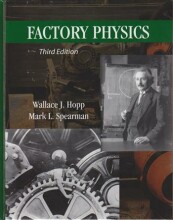Basic Factory Dynamics - Labor-Constrained Systems
4 important questions on Basic Factory Dynamics - Labor-Constrained Systems
Why do the workers in the definition on p. 255 have to be fully cross-trained?
If they cannot perform all jobs, they will have to wait on a specialist for jobs they cannot perform. Hence blocking occurs and T0 would increase.
Why does it make sense to put the slowest workers upstream and the fastest ones downstream in a bucket brigade type system? What would happen if you switch this around?
If you would have the slowest workers downstream and the fastest upstream, work would pile up the more downstream you would look (when assuming inter-station inventories/buffers) or a lot of blocking would occur (when not assuming inter-station inventories/buffers).
When the fastest workers are downstream, starving is more likely to happen and WIP is minimized (and low WIP leads to high flexibility).
What is a chaining policy?
Chaining is a type of cross-training where a worker is only partially cross-trained and covers a limited zone of workstations, where zones overlap. In effect, a worker is fully cross-trained within his/her zone.
- Higher grades + faster learning
- Never study anything twice
- 100% sure, 100% understanding
The Batavus company produces bicycles. Inmagine a maximum throughput (THmax) of 34 bikes per hour. The raw processing time (T0) for the production equals 0,5 hours. How many crosstrained operators with identical work rates does Batavus need in order to achieve the THmax?
from this, it follows that
n( # of crosstrained operators needed) = 34 * 0,5 = 17 operators
The question on the page originate from the summary of the following study material:
- A unique study and practice tool
- Never study anything twice again
- Get the grades you hope for
- 100% sure, 100% understanding
































